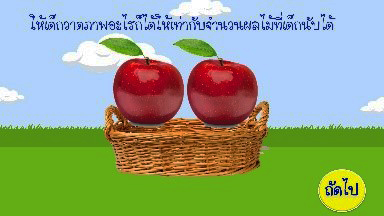ผลการใช้ชุดสื่อการเรียนรู้ดิจิทัลเพื่อส่งเสริมการรู้จำนวนสำหรับเด็กปฐมวัย
Main Article Content
Abstract
Kunphatson Foithong, Oraphan Butkatunyoo and Piyanan Hirunchalothorn
รับบทความ: 20 พฤษภาคม 2567; แก้ไขบทความ: 26 กรกฎาคม 2567; ยอมรับตีพิมพ์: 28 กรกฎาคม 2567; ตีพิมพ์ออนไลน์: 24 ธันวาคม 2567
บทคัดย่อ
การศึกษาวิจัยในครั้งนี้มีวัตถุประสงค์เพื่อเปรียบเทียบผลการใช้ชุดสื่อการเรียนรู้ดิจิทัลเพื่อส่งเสริมการรู้จำนวนสำหรับเด็กปฐมวัย กลุ่มเป้าหมายที่ใช้ในการศึกษาวิจัยในครั้งนี้ คือ เด็กปฐมวัยที่มีอายุ 5–6 ปี กำลังศึกษาอยู่ในระดับชั้นอนุบาล 3 ภาคเรียนที่ 2 ประจำปีการศึกษา 2566 โรงเรียนแห่งหนึ่งสังกัดสำนักงานเขตพื้นที่การศึกษาประถมศึกษานครปฐม เขต 2 จำนวน 13 คน เครื่องมือที่ใช้ในการศึกษาวิจัย ได้แก่ ชุดสื่อการเรียนรู้ดิจิทัลเพื่อส่งเสริมการรู้จำนวนสำหรับเด็กปฐมวัย จำนวน 8 ชุด และแบบประเมินการรู้จำนวนของเด็กปฐมวัย วิเคราะห์ข้อมูลเชิงปริมาณโดยใช้ค่าเฉลี่ย ค่าส่วนเบี่ยงเบนมาตรฐาน และวิเคราะห์ข้อมูลเชิงคุณภาพ โดยการวิเคราะห์เนื้อหา ผลการศึกษาพบว่าผลการใช้ชุดสื่อการเรียนรู้ดิจิทัลเพื่อส่งเสริมการรู้จำนวนของเด็กปฐมวัย มีคะแนนหลังการทดลองสูงกว่าก่อนการทดลอง ทั้งโดยรวมและรายด้านซึ่งการใช้ชุดสื่อการเรียนรู้ดิจิทัลสามารถพัฒนาการรู้จำนวนของเด็กปฐมวัย โดยเด็กสามารถเข้าใจเกี่ยวกับการสำรวจวัตถุ เข้าใจเกี่ยวกับการนับและบอกจำนวนวัตถุ เข้าใจเกี่ยวกับการมองภาพของวัตถุ เข้าใจเกี่ยวกับสัญลักษณ์แทนจำนวน เข้าใจเกี่ยวกับการแสดงวิธีการแก้ไขปัญหา วิธีการเหล่านี้สามารถเป็นแนวทางในการจัดกิจกรรมสำหรับครูหรือผู้ที่สนใจเกี่ยวกับการจัดกิจกรรมโดยใช้ชุดสื่อการเรียนรู้ดิจิทัล เพื่อส่งเสริมการรู้จำนวนให้เด็กปฐมวัย
คำสำคัญ: การรู้จำนวน ชุดสื่อการเรียนรู้ดิจิทัล เด็กปฐมวัย
Abstract
The objective of this research was to compare the results of using digital learning media sets to promote numeracy for young children. The target group for this research study are 13 young children aged 5–6 years who are studying in the kindergarten level 3 in the second semester of the academic year 2023 at a school in Nakhon Pathom province, the Nakhon Pathom Primary Educational Service Area Office District 2. The tools used in the research include 8 sets of digital learning media to promote number literacy for young children and an assessment form of young children’s numeracy of young children.Quantitative data were analyzed using averages and standard deviation; qualitative data were analyzed by way of content analysis. The research findings showed that the use of digital learning media sets to promote numeracy among young children, both overall and in each aspect, yielded higher post–experiment scores than pre–experiment scores. The use of digital learning media sets can develop young children’s numeracy. Children were able to understand exploring objects, understand counting and telling the number of objects, understand the visualization of objects, understand symbols that represent numbers and understand how to display solutions. These methods can serve as guidelines for organizing activities for teachers or those who are interested in organizing activities using digital learning media sets to promote numeracy in young children.
Keywords: Numeracy, Digital learning sets, Young children
Downloads
Article Details

This work is licensed under a Creative Commons Attribution-NonCommercial 4.0 International License.
References
Dulyakorn, V. (2022). End All Learning Activities with One Tool. Retrieved from https://www.starfishlabz.com/blog/1047-classpoint-ep-2, August 7, 2023. (in Thai)
Hemachayat, W., and Siritho, V. (2022). Promoting counting abilities of early childhood children by using vegetable counting game. Journal of Early Childhood Education Management 4(2): 19–28. (in Thai)
Holiday Educationist. (2024). Importance of Numeracy in Early Childhood. Retrieved from https://www.holidayeducationist.com/importance-of-numeracy-in-early-childhood, July 24, 2024.
Ministry of Education Republic of Singapore. (2013). Nurturing Early Learners a Curriculum for Kindergartens in Singapore Numeracy. Singapore: Author.
Ministry of Education. (2017). Early Child-hood Education Curriculum, 2017. Bangkok: Teachers Council, Lat Phrao. (in Thai)
National Association for the Education of Young Children (NAEYC), & the Fred Rogers Center. (2012). Technology in Early Childhood Programs Serving Children from Birth through Age 8. Retrieved from http://www.naeyc.org/files/naeyc/file/positions/PS_technology_WEB2.pdf, May 15, 2023.
Office of the Secretariat of the Education Council Ministry of Education. (2020). Guidelines for Developing Learning Resources in the Digital Age that Are Appropriate for Early Childhood Learners. Nonthaburi: Seijuri. (in Thai)
Pracharo, A., and Butkatunyoo, O. (2021). The Development of Young Children’s Number and Operations Understanding by using Literature Based Learning and Digital Media. Retrieved from https://anyflip.com/yurjq/kjsv/basic, July 13, 2024. (in Thai)
Sitthirat, T. (2024). Active Students Easily by Using Class Point. Retrieved from https://www.starfishlabz.com/blog/1609-นักเรียน-active-ได้ง่ายๆแค่ใช้-class-point, July 13, 2024. (in Thai)
The Institute for the Promotion of Teaching Science and Technology [IPST]. (2023). Press Conference on PISA 2022 Assessment Results. Retrieved from https://pisathailand.ipst.ac.th/news-21, December 2, 2023. (in Thai)
The Institute for the Promotion of Teaching Science and Technology [IPST]. (2017). Learning Framework and Guidelines for Organizing Learning Experiences Integrating Science, Technology, and Mathematics at the Early Childhood Level According to the Early Childhood Education Curriculum, 2017. Bangkok: Gogo Print. (in Thai)
World Academy. (2024). Digital Literacy: Why is it Important for Your Child? Retrieved from https://www.xwa.edu.sg/blog/parents/digital-literacy-why-important-children/#, May 2, 2023.
